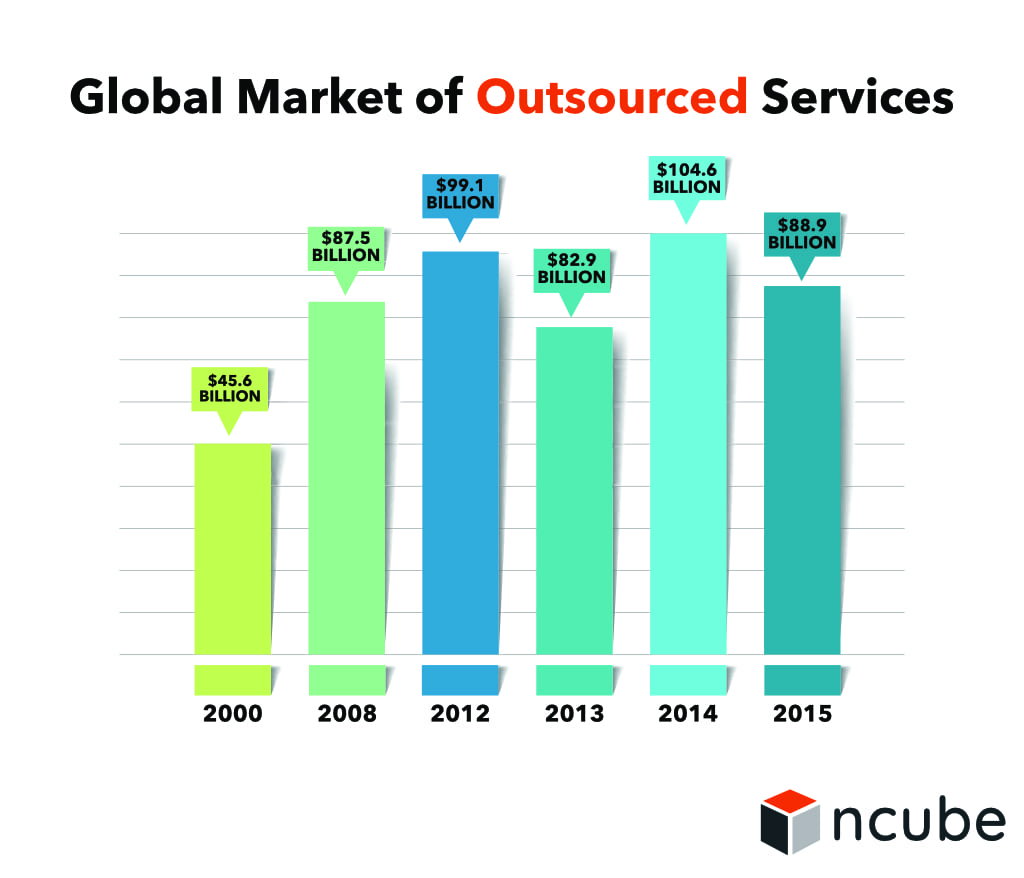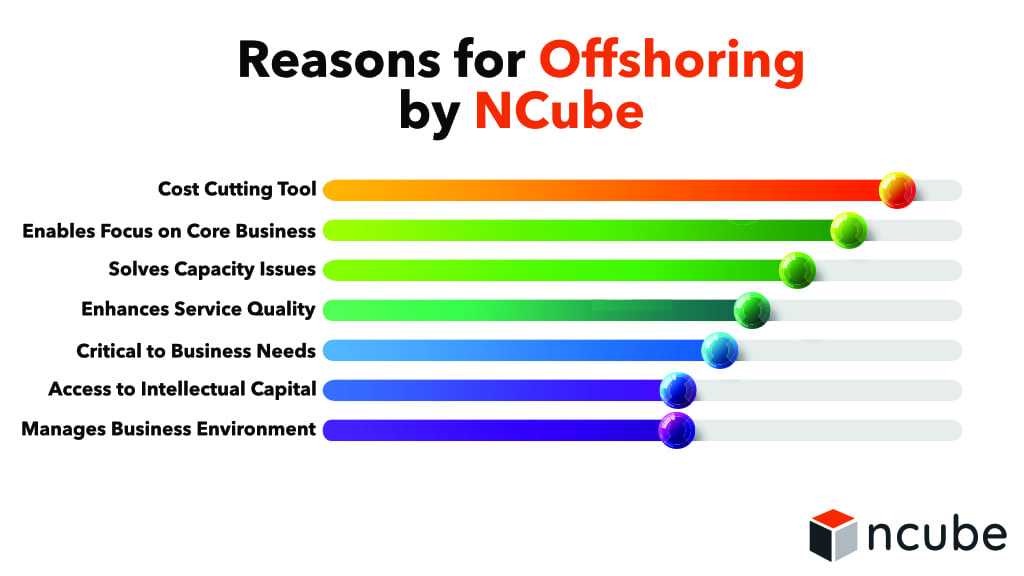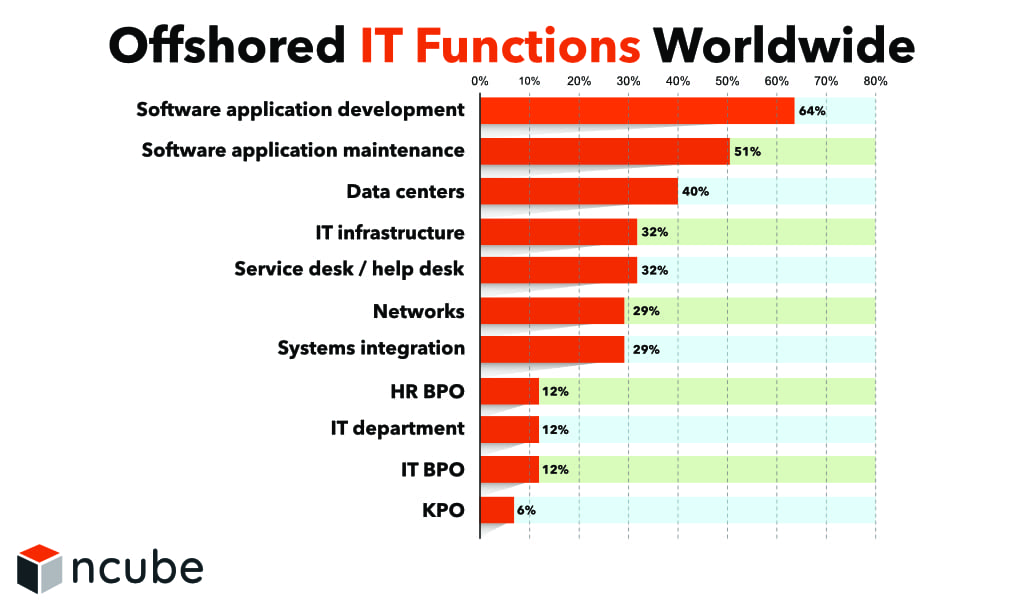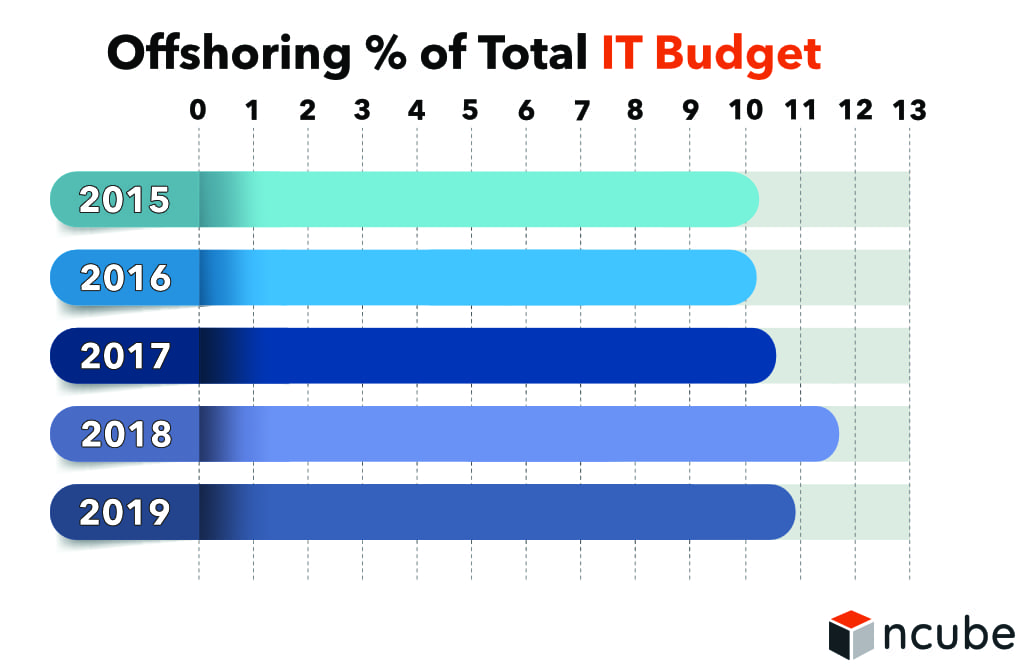Providers of offshore IT services have long since proven their worth. The flexibility of this solution helps organizations reduce overhead and switch to more cost-effective resources when drastic cutbacks are required. If you’re still weighing the positives and negatives of this approach, this post aims to complement your vision of the topic and help you understand if it’s suitable for your business.
Before we dive into the pros and cons of IT offshore outsourcing, let’s define it. In this approach, you delegate your software development activities to vendors of offshore IT services located overseas or in a location at a significant distance from your headquarters. For instance, we at nCube provide offshore IT staffing in regions such as Central and Eastern Europe (Poland, Ukraine, Romania, the Baltics), Western Asia (Armenia, Azerbaijan, Georgia), and Latin America (Brazil, Argentina, Mexico). These countries have a strong potential to become centers of software development excellence for EU and North American companies due to various reasons:
- Large talent pools with a wide range of tech skills: Over 2 million software engineers;
- Skilled software engineering teams at reasonable rates;
- Strong focus on high-quality STEM education;
- Effective communications and alignment with Western business approaches;
- Partial or full workday overlap with North American and EU time zones.
Thanks to these reasons, offshore IT staffing as an approach to expanding internal tech units is quite popular these days. According to Statista, in 2024, the market of offshore IT services will reach 512.47 billion dollars in revenue.
Below is a brief overview of the strengths and weaknesses of this approach.

Now let’s go over the pros and cons of IT offshore outsourcing in more detail.
Pros of offshore IT services:
- Cost reduction
The high cost of in-house software development is the main reason prompting businesses to delegate their software development tasks to overseas providers. As Accelerance reports, businesses can save from 40% to 70% of overall costs by partnering with offshore IT services. Not only are the rates of software engineers lower in offshore regions but also overseas facilities let you cut back on team administration, retention, and IT infrastructure expenses.
- Access to a wide range of tech skills
Many EU and North American companies struggle to find developers adept at popular programming languages (Java, JavaScript, Python, PHP, etc) and in-demand technologies (IoT, AI/ML, Blockchain, etc) alike. When weighing the pros and cons of IT offshore outsourcing, the shortage of local skilled technologists is a significant argument in favor of offshore IT staffing. Such offshoring regions as Central & Eastern Europe and Latin America boast large pools of quality tech skills (over 2 million software developers combined), which makes them ideal destinations for offshore IT staffing.
- Scaling up and down easily
In the ever-evolving market, offshore IT services offer a high level of agility that companies need to adapt quickly. It’s a fact that offshore facilities are easy to scale. So, when your project requires more skills, chances are you can build a full-blown team within several weeks thanks to vast networks of software engineers. On the other hand, when you need to disband or reduce your unit, providers of offshore IT staffing can do it on short notice.
- Speeding up your current project
Providers of offshore IT staffing can help free up your core team from routine tasks. Unlike the outsourcing model, where a team takes on a project and develops it from the ground up, offshore developers can step in at any stage of the project and bring it up to speed quickly. On the other hand, offshore development squads require a great deal of involvement on your part. Although it acts as an autonomous unit, your offshore team will follow your lead and interact with you directly.
Disadvantages of offshore IT staffing
When it comes to the pros and cons of IT offshore outsourcing, it’s worth reviewing the following negatives that can potentially impede cooperation with your offshore unit.
- Time difference
In this day and age, remote collaboration is the norm. However, it can be hard to establish efficient communications among team members located in different time zones. With this in mind, many companies choose to stick to in-house teams.
READ ALSO: Offshore Development Center vs. In-House Team: Which one is Best for You?
Yet, there’s another way to look at the time zone challenge – an offshore development model comes with a unique overlapping coverage. In a 24-hour timeline, your internal and offshore team will dedicate 8 hours per day each, which equals 16 hours of work done in a day.
- A laborious management process
While your offshore squad will be fully dedicated to achieving your goals, you’ll be deeply involved in the software development process. From team formation to managing your offshore unit, the client of offshore IT services is responsible for team management, setting up workflows, and communications. The provider typically covers employee retention, HR processes, overhead, IT infrastructure, but the project’s outcome is always the client’s responsibility.
- Communication barriers
Offshoring is a multicultural concept, given that the team members will have diverse communication patterns, as they typically stem from different cultures and backgrounds. That being said, offshore IT services should facilitate providing developers with in-depth language proficiency and a track record of being a part of offshore development projects.
- Intellectual Property
Letting providers of offshore IT services handle your operations can pose IP risks. Thus, it’s a good practice to implement security standards and strategies on your side rather than relying solely on your offshoring partner, even if they’ve signed a Non-Disclosure Agreement.
READ ALSO: IT Outsourcing Market in Latin America: An Overview
Popular destinations for IT offshore outsourcing
One of the major offshore software development benefits is the ability for companies to select among a variety of IT hubs and find developers who perfectly match their competence needs, rates, experience, ability to work in a distributed environment, and other relevant aspects. Let’s take a look at destinations that reign supreme in IT offshore outsourcing.
Central and Eastern Europe (CEE)
CEE offers good value for money, which is why it is recognized globally as one of the best hotspots for IT offshore outsourcing. The primary beneficiaries of this region are North American companies that rely on the strong IT potential of Poland, Ukraine, the Czech Republic, Hungary, Bulgaria, and Romania, which collectively have around 1 million software developers.
Skills: The region is home to skilled developers with expertise spanning various industries. When it comes to programming languages, the region is a solid repository of JavaScript (front-end and back-end), Java, PHP, Python, Ruby, Android, iOS, and AI/ML talent. CEE is also a good place to hire experts in such sectors as Finance/Banking, Healthcare, Security, Gaming, Automotive, and other industries.
Time zone: A significant offshore software development benefit of CEE is an ample time window for real-time collaboration. This makes it an ideal spot to build a nearshore unit if you’re located in Western Europe and the UK, ensuring complete alignment between your remote and internal team members when working on your project. When it comes to offshore outsourcing, despite differences in time zones, there are usually a few hours of overlapping work time.
Cost: The cost of IT offshore outsourcing in CEE varies from $21 to $118 per hour, excluding vendor fees, as per Accelerance. To find more affordable rates, Ukraine, Moldova, Romania, and Bulgaria are good options, while the Czech Republic, Hungary, and Poland have higher costs of living, which can affect pricing.
Latin America (LATAM)
LATAM is the go-place region for many companies in times of after-Covid belt-tightening. LATAM’s top IT offshoring/nearshoring destinations include Brazil, Argentina, and Mexico, with an estimated pool of one million IT experts. Brazil alone accounts for half of this talent repository. If you’re a tech leader looking for outsourcing opportunities, let’s explore what LATAM has to offer.
Skills: LATAM’s IT labor market is thriving, with a strong IT sector, startup culture, and new tech education initiatives. Brazil, Argentina, and Mexico rank high in tech and innovation skills according to various reports (Coursera’s Global Skill Report, Global Innovation Index, SkillValue Ranking, etc.) Argentine developers are skilled in computer programming, mobile dev, and Cloud computing, while Mexican developers excel in data analysis, mobile development, and Python/C++ skills. Brazilian developers play strong in cloud computing, data management, and software programming, specializing in languages like JavaScript, HTML, SQL, Java, Node.js, and Python.
Time zone: If you’re located in the USA, LATAM is a true gem when it comes to synchronizing remote and in-house teams. Mexico shares the same time zone as the USA, offering up to 8 hours of overlap, while Brazil and Argentina are in the EST time zone, providing up to 7-5 hours of shared regular work hours with businesses in the US, which is more beneficial than software offshoring.
Costs: The hourly rates for nearshore outsourcing to Latin America are comparable to those in CEE, typically ranging from $28 to $105 per hour, excluding vendor fees. However, it’s worth noting that Brazil tends to have higher rates than Mexico and Argentina, according to Clutch’s data on developer rates.
When it comes to IT offshore outsourcing, it would be remiss not to acknowledge the significant role of Asian countries as a talent powerhouse that has dominated the outsourcing market for decades, primarily due to their cost-effectiveness. But offshoring there can be a double-edged sword, with high chances of compromising between the price and quality. Therefore, in the 2010s, global tech leaders began exploring alternative outsourcing hubs in Eastern Europe and later in LATAM.
READ ALSO: Offshore Product Development: Eastern Europe, Latin America or Asia?
Your reliable offshore IT staffing provider | nCube
As a company that provides offshore IT staffing, we strive to help you make the most of offshore IT services. Here’s what our approach includes:
A full dedication approach
We aim to strengthen your in-house unit with fully dedicated resources. The engineers we source for you will join your team on a full-time basis, working for you 5 days/40 hours per week. In our approach, engineers will follow your engineering practices and communication patterns as well as adopt your company culture. This way, your offshore team becomes a part of your organization, supplementing your home-based squad.
A customized team formation process
Each client is unique, so we will dive into our network to find candidates that fully match your requirements when it comes to tech skills, company culture fit, English, and other competencies. We are always ready to go the extra mile when it comes to meeting your offshore IT staffing needs.
No intermediaries between you and your team
With us, you will work with and communicate with your offshore team members directly, retaining full control over the provided team. Our approach assumes you will assign tasks and manage the software development process as you see fit.
Only skilled software engineers
As a provider of offshore IT services in Central & Eastern Europe and LATAM, we offer you the opportunity to add best-in-class talent to your team. All developers you’ll meet have undergone our internal screening process, including tech skills, company fit, and English tests. On top of that, the market in our targeted offshore locations is studded with quality engineers with experience working at offshore IT services for EU, UK, and North American companies, which guarantees excellent English skills and domain experience.
Let’s connect to discuss the pros and cons of IT offshore outsourcing for your organization and how nCube can help you build your offshore unit.
Providers of offshore IT services have long since proven their worth. The flexibility of this solution helps organizations reduce overhead and switch to more cost-effective resources when drastic cutbacks are required. If you’re still weighing the positives and negatives of this approach, this post aims to complement your vision of the topic and help you understand if it’s suitable for your business.
Before we dive into the pros and cons of IT offshore outsourcing, let’s define it. In this approach, you delegate your software development activities to vendors of offshore IT services located overseas or in a location at a significant distance from your headquarters. For instance, we at nCube provide offshore IT staffing in regions such as Central and Eastern Europe (Poland, Ukraine, Romania, the Baltics), Western Asia (Armenia, Azerbaijan, Georgia), and Latin America (Brazil, Argentina, Mexico). These countries have a strong potential to become centers of software development excellence for EU and North American companies due to various reasons:
- Large talent pools with a wide range of tech skills: Over 2 million software engineers;
- Skilled software engineering teams at reasonable rates;
- Strong focus on high-quality STEM education;
- Effective communications and alignment with Western business approaches;
- Partial or full workday overlap with North American and EU time zones.
Thanks to these reasons, offshore IT staffing as an approach to expanding internal tech units is quite popular these days. According to Statista, in 2021, the market of offshore IT services reached 413 billion dollars in revenue. Let’s go over the pros and cons of IT offshore outsourcing in more detail.
READ ALSO: IT Outsourcing Market in Latin America: An Overview
Pros of offshore IT services:
- Cost reduction
The high cost of in-house software development is the main reason prompting businesses to delegate their software development tasks to overseas providers. As Accelerance reports, businesses can save from 40% to 70% of overall costs by partnering with offshore IT services. Not only are the rates of software engineers lower in offshore regions but also overseas facilities let you cut back on team administration, retention, and IT infrastructure expenses.
- Access to a wide range of tech skills
Many EU and North American companies struggle to find developers adept at popular programming languages (Java, JavaScript, Python, PHP, etc) and in-demand technologies (IoT, AI/ML, Blockchain, etc) alike. When weighing the pros and cons of IT offshore outsourcing, the shortage of local skilled technologists is a significant argument in favor of offshore IT staffing. Such offshoring regions as Central & Eastern Europe and Latin America boast large pools of quality tech skills (over 2 million software developers combined), which makes them ideal destinations for offshore IT staffing.
- Scaling up and down easily
In the ever-evolving market, offshore IT services offer a high level of agility companies need to adapt quickly. It’s a fact that offshore facilities are easy to scale. So, when your project requires more skills, chances are you can build a full-blown team within several weeks thanks to vast networks of software engineers. On the other hand, when you need to disband or reduce your unit, providers of offshore IT staffing can do it on short notice. Thanks to this, the team reduction doesn’t incur additional expenses.
- Speeding up your current project
Providers of offshore IT staffing can help free up your core team from routine tasks. Unlike the outsourcing model, where a team takes on a project and develops it from the ground up, offshore developers can step in at any stage of the project and bring it up to speed quickly. On the other hand, offshore development squads require a great deal of involvement on your part. Although it acts as an autonomous unit, your offshore team will follow your lead and interact with you directly and will be fully integrated into your internal processes.
- Continuous coding collaboration
IT offshoring helps companies incorporate the concept of continuous software development. When an engineer completes their work in one time zone, their colleague in a different time zone picks up the slack and continues the development process. This practice guarantees an uninterrupted workflow that transcends geographical boundaries and time zone differences. Besides that, this approach is convenient for a non-stop maintenance process.
Disadvantages of offshore IT staffing
When it comes to the pros and cons of IT offshore outsourcing, it’s worth reviewing the following negatives that can potentially impede cooperation with your offshore unit.
- Time difference
In this day and age, remote collaboration is the norm. However, it can be hard to establish efficient communications among team members located in different time zones. With this in mind, many companies choose to stick to in-house teams.
READ ALSO: Offshore Development Center vs. In-House Team: Which one is Best for You?
Yet, there’s another way to look at the time zone challenge – an offshore development model comes with a unique overlapping coverage. In a 24-hour timeline, your internal and offshore team will dedicate 8 hours per day each, which equals 16 hours of work done in a day.
- A laborious management process
While your offshore squad will be fully dedicated to achieving your goals, you’ll be deeply involved in the software development process. From team formation to managing your offshore unit, the client of offshore IT services is responsible for team management, setting up workflows, and communications. The provider typically covers employee retention, HR processes, overhead, IT infrastructure, but the project’s outcome is always the client’s responsibility.
- Communication barriers
Offshoring is a multicultural concept, given that the team members will have diverse communication patterns, as they typically stem from different cultures and backgrounds. That being said, offshore IT services should facilitate providing developers with in-depth language proficiency and a track record of being a part of offshore development projects.
- Intellectual Property
Letting providers of offshore IT services handle your operations can pose IP risks. Thus, it’s a good practice to implement security standards and strategies on your side rather than relying solely on your offshoring partner, even if they’ve signed a Non-Disclosure Agreement.

Popular destinations for IT offshore outsourcing
One of the major offshore software development benefits is the ability for companies to select among a variety of IT hubs and find developers who perfectly match their competence needs, rates, experience, ability to work in a distributed environment, and other relevant aspects. Let’s take a look at destinations that reign supreme in IT offshore outsourcing.
Central and Eastern Europe (CEE)
CEE offers good value for money, which is why it is recognized globally as one of the best hotspots for IT offshore outsourcing. The primary beneficiary of this region includes North American companies looking that rely on the strong IT potential of Poland, Ukraine, the Czech Republic, Hungary, Bulgaria, and Romania, which collectively have around 1 million software developers.
Skills: The region is home to skilled developers with expertise spanning a wide range of industries. When it comes to programming languages, the region is a solid repository of JavaScript (front-end and back-end), Java, PHP, Python, Ruby, Android, iOS, and AI/ML talent. CEE is also a good place to hire experts in such sectors as Finance/Banking, Healthcare, Security, Gaming, Automotive, and other industries.
Time zone: A significant offshore software development benefit of CEE is an ample time window for real-time collaboration. This makes it an ideal spot to build a nearshore unit if you’re located in Western Europe and the UK, ensuring complete alignment between your remote and internal team members when working on your project. When it comes to offshore outsourcing, despite differences in time zones, there are usually a few hours of overlapping work time.
Cost: The cost of IT offshore outsourcing in CEE varies from $21 to $118 per hour, excluding vendor fees, as per Accelerance. To find more affordable rates, Ukraine, Moldova, Romania, and Bulgaria are good options, while the Czech Republic, Hungary, and Poland have higher costs of living, which can affect pricing.
Latin America (LATAM)
LATAM is the go-place region for many companies in times of after-Covid belt-tightening. LATAM’s top IT offshoring/nearshoring destinations include Brazil, Argentina, and Mexico, with an estimated pool of one million IT experts. Brazil alone accounts for half of this talent repository. If you’re a tech leader looking for outsourcing opportunities, let’s explore what LATAM has to offer.
Skills: LATAM’s IT labor market is thriving, with a strong IT sector, startup culture, and new tech education initiatives. Brazil, Argentina, and Mexico rank high in tech and innovation skills according to various reports (Coursera’s Global Skill Report, Global Innovation Index, SkillValue Ranking, etc.) Argentine developers are skilled in computer programming, mobile dev, and Cloud computing, while Mexican developers excel in data analysis, mobile development, and Python/C++ skills. Brazilian developers play strong in cloud computing, data management, and software programming, specializing in languages like JavaScript, HTML, SQL, Java, Node.js, and Python.
Time zone: If you’re located in the USA, LATAM is a true gem when it comes to synchronizing remote and in-house teams. Mexico shares the same time zone as the USA, offering up to 8 hours of overlap, while Brazil and Argentina are in the EST time zone, providing up to 7-5 hours of shared regular work hours with businesses in the US, which is more beneficial than software offshoring.
Costs: The hourly rates for nearshore outsourcing to Latin America are comparable to those in CEE, typically ranging from $28 to $105 per hour, excluding vendor fees. However, it’s worth noting that Brazil tends to have higher rates than Mexico and Argentina, according to Clutch’s data on developer rates.
When it comes to IT offshore outsourcing, it would be remiss not to acknowledge the significant role of Asian countries as a talent powerhouse that has dominated the outsourcing market for decades, primarily due to their cost-effectiveness. But offshoring there can be a double-edged sword, with high chances of compromising between the price and quality. Therefore, in the 2010s, global tech leaders began exploring alternative outsourcing hubs in Eastern Europe and later in LATAM.
READ ALSO: Offshore Product Development: Eastern Europe, Latin America or Asia?
Your reliable offshore IT staffing provider | nCube
As a company that provides offshore IT staffing, we strive to help you make the most of offshore IT services. Here’s what our approach includes:
A full dedication approach
We aim to strengthen your in-house unit with fully dedicated resources. The engineers we source for you will join your team on a full-time basis, working for you 5 days/40 hours per week. In our approach, engineers will follow your engineering practices and communication patterns as well as adopt your company culture. This way, your offshore team becomes a part of your organization, supplementing your home-based squad.
A customized team formation process
Each client is unique, so we will dive into our network to find candidates that fully match your requirements when it comes to tech skills, company culture fit, English, and other competencies. We are always ready to go the extra mile when it comes to meeting your offshore IT staffing needs.
No intermediaries between you and your team
With us, you will work with and communicate with your offshore team members directly, retaining full control over the provided team. Our approach assumes you will assign tasks and manage the software development process as you see fit.
Only skilled software engineers
As a provider of offshore IT services in Central & Eastern Europe and LATAM, we offer you the opportunity to add best-in-class talent to your team. All developers you’ll meet have undergone our internal screening process, including tech skills, company fit, and English tests. On top of that, the market in our targeted offshore locations is studded with quality engineers with experience working at offshore IT services for EU, UK, and North American companies, which guarantees excellent English skills and domain experience.
Let’s connect to discuss the pros and cons of IT offshore outsourcing for your organization and how nCube can help you build your offshore unit.
As a viable way to save costs and access talent with various backgrounds, offshore software development has become increasingly popular in recent years. If you’re considering going with this approach, your options range from sourcing offshore developers via one of the freelancing platforms to cooperating with a virtual team partner. The latter is typically the most convenient way to handle offshore software development.
The common question is: How much does it cost to hire offshore developers? Typically, offshoring development rates boil down to several factors, a geographic location being the most significant rate determinant.
In this article, we take a look at software development rates in the most popular offshoring destinations, so you can make an informed decision when choosing the offshoring development destination.
Offshoring development rates: Central and Eastern Europe (CEE)

Chances are you’re not only aiming to reduce the cost of development but also want to source highly qualified software engineers. Then, Central and Eastern Europe (CEE) is the best way to go.
CEE boasts over 1 million software engineers, which makes it an attractive offshoring development destination. With the growing number of IT professionals, the region’s countries have taken significant steps to foster the development of their IT markets.
Generally, IT specialists based in CEE are deemed to offer a higher quality of work than their Asian counterparts, which can be attributed to the fact that offshore developers in this region have access to strong, Europe-quality academic education.
When it comes to the number of offshore developers, Poland takes the lead with roughly 225,000 professionals involved in software development offshoring. Ukraine is ranked second with nearly 185,000 IT specialists. According to PayScale, both countries are well-positioned to offer competitive rates, with an average of $15 per hour.
Offshoring development rates: Asia

Asia spans many countries and includes cost-effective and expensive offshore destinations, offering a variety of offshoring development rates. For example, in India, one of the largest and most cost-effective offshoring software development destinations, you can hire an offshore developer for under $20 per hour. The downside of such an offshoring destination is a significant time zone difference and increased managerial effort associated with managing a team that constitutes people with a different mentality and work ethics.
China also plays strong in the offshore software development field, offering similar to CEE’s offshoring rates in the range of $25–$40 per hour. While the price-quality ratio is more than reasonable, a significant concern is IP protection. On the other hand, the Chinese government supports the IT industry by providing economic incentives and investing in technology parks where offshore developers can develop professionally.
Other countries of the region, such as Japan, Vietnam, Indonesia, and Malaysia can be a good option, given the quality to cost ratio. Offshore developers in Japan can earn only $20 per hour on average, even though the country is rightfully considered to be the cradle of cutting-edge technologies. Senior engineers in the countries mentioned above usually charge $30–$40 per hour.
Asia’s peculiarity is that it has an equal number of highly skilled vs. semi-skilled offshore developers. An offshore software vendor that has entered the global IT market is likely to charge as high as $30-$60 for a full-time offshore developer. As such, if you are not willing to roll the dice, it’s best to consider other regions, where moderate hourly rates for offshore software development and high-quality software solutions aren’t such a rare combination.
Offshoring development rates: Latin America

Latin America is well-positioned to be the preferred offshore software development region for US-based companies. The geographic proximity enables the teams to synchronize effortlessly, communicating in real-time. In addition, the continent offers cultural and social affinity, as well as high English proficiency.
The ease of travel is a fundamental reason why North American companies decide to choose this region. The geographical proximity allows visiting the offshoring development squad regularly, which is more challenging with European and Asia-based teams.
Although software development rates in most Latin American countries are higher than in Asia or Eastern Europe, offshoring development remains a viable way to develop software compared to sourcing local resources.
The hotbeds of offshore software development include Brazil, Argentina, and Mexico, where the hourly offshoring development rates vary between $30–$50. Cheaper options include Chile, Panama, Costa Rica, and Peru, where a full-time offshore developer charges between $15–$25.
Offshoring development rates: Africa

Africa is a new entrant in the software offshoring market. Currently, the IT job market in Africa is far from being an offshoring development hot spot like Eastern Europe or Asia.
According to Accelerance, South Africa, Egypt, Morocco, Tunisia, Kenya, and Nigeria are the most promising countries that spearhead the continent’s IT industry. Morocco, Egypt, and Kenya offer the average offshore development rate of $20.
Offshore software development rates are higher in Nigeria, and South Africa since the job market in those countries is less saturated, making it hard to find highly qualified offshore developers at moderate prices. Tunisia and Morocco are the preferred destinations for French-speaking countries, whereas the rest of the continent is a vast Arabic and English-speaking talent pool.
Final thoughts: software development offshoring with nCube
Offshore development rates depend on where you are hiring a team, and thus can vary drastically. Typically, they stay in the range of $15-50 per hour.
What should you consider when hiring an offshore developer? The rates are affected by an offshore developer’s experience, seniority, and background. Needless to say that the more experience an offshore developer has, the more they will charge.
The countries of Latin America top the list of countries with the highest rates for software development offshoring. On the other hand, Eastern Europe offers a vast pool of qualified talent at moderate prices. In contrast, the Asian and African IT job market is filled with low-rate job seekers, so choosing this region may save you money but will not guarantee a high-quality end product.
We at nCube have been building development teams of Ukrainian developers for over a decade. We work for Western companies that chose Ukrainian developers for their strong tech background, problem-solving mindset, and high English proficiency. Contact us for more details on our offshoring development model.
Changes in global markets and advances in technology have changed how offshore information technology companies work. While the geographic location is an essential consideration in other industries, organizations in the IT industry are much more open to a multi-location structure and hiring offshore developers. That means IT companies can capitalize on the strengths of each of their sites.
During its early years, companies considered IT offshoring to take advantage of lower overhead and potential growth. However, as technology took over the world, more and more organizations began to increase their investments in IT. Eventually, hiring offshore developers became a viable option.
The last decade brought significant changes to how businesses used and consumed IT products and resources. The advent of cloud technology improved global communication, and even the increased interconnection of global cultures have significantly changed IT offshoring work.
In this article, we will take a look at our findings on the current state of IT offshoring and outsourcing, including recent trends, driving forces, and what changed in the past years
Outsourcing vs. offshore developers
You may be asking companies to use offshoring to do what? Well, back in the early years of offshoring and outsourcing, the two business processes are easily separated. However, as globalization and internationalization permeated practically every industry, various concepts have begun to float around, blurring the line between the two.
Traditionally, offshoring refers to the organization’s movement of its activities abroad. On the other hand, outsourcing means moving activities to an offshore developers provider, regardless of its location.
However, recent decades have changed these definitions drastically. Companies that use offshore developers have combined all or parts of business offshoring and outsourcing processes to become interchangeable. That gave way to concepts such as multi-sourcing, offshore outsourcing, nearshoring, offshore IT companies, offshore software development, selective sourcing, and more.
To simplify, we define offshoring and outsourcing as providing administrative services in locations abroad, whether through an in-house department or a third-party service provider. Companies often have teams worldwide, usually combining internal teams working remotely and offshore developers hired through outsourcing entities. Hence, we will use offshoring to refer to all the concepts described above from this point on.
The current state of offshore information technology and related industries
Offshoring is not a modern phenomenon. Each generation has different motives attributed to market demands, technological advancements, and cultural intermingling.
In the past, offshoring was centered around goods. Organizations take advantage of affordable production costs and efficient distribution networks. For example, Sweden has long been known to be a popular offshoring destination for organizations in the shipbuilding, textile, and manufacturing industries in Europe.
However, modern-day offshoring efforts are driven by offshore information technology rather than goods. Thus, there was a noticeable shift in the driving forces between the late ’80s and early ’90s, which continues to this day.
First, and obviously, such low costs drive companies to consider offshore software development to maximize their profits. Second, countries outside the United States are beginning to develop their own offshore IT companies. These budding markets are perfect grounds where established companies can take new roots before prices go up. Lastly, unique factors such as excellent yet affordable infrastructure, advanced technologies, similar culture, language, and other special competencies drive companies to relate some parts of their organization, specifically the offshore information technology units.
The global state of offshore IT companies

Closely related to IT services are business processes that are commonly outsourced to BPO’s abroad. So much so that entire BPO industries have developed in India, the Philippines, and most Eastern Europe. As such, global offshore software development expenses have steadily increased throughout the years.
Since 2000, the influx of organizations entering new locations has pushed offshore information technology to new heights.

However, 2016 recorded the worst market report with only $76.9 billion, the lowest in a decade. The primary motivation of the decreasing market was the effort to cut costs and focus on core business processes. This means more organizations are spending more on new solutions through IT services than on offshore developers.

The trends in offshore IT companies had exciting effects on the IT industry. In 2018, business process outsourcing had a much smaller market share than information technology offshoring. The BPO industry only contributed $23.6 billion compared to the offshore information technology’s $62 billion offshoring revenue.
The 2017 report of the most outsourced and offshored services of IT leaders worldwide reflects this trend as well. Software application development took the top spot at 64 percent. Similarly, IT functions dominate the top offshored services in the last few years.

Interestingly, there is a rising trend in the IT offshoring business in recent years. Between 2017 and 2018, there is a slight drop in allotted budgets for offshore software development. Even with large companies increasing their total expenditures, medium and small companies are turning to cloud technology, which is much more affordable.

Again, this recent trend seems to reflect the prediction during 2016 when cloud technology is taking off rapidly and set to disrupt the global market.
Offshore developers: training and opportunities
With the move from exclusively outsourcing from the labor force to offshoring IT services, offshore developers have become the top export of most outsourcing countries. In the above graph, access to intellectual capital is one of the driving forces of offshore IT companies.
The skill level and prices are top priorities in hiring offshore teams. Eastern Europe and the surrounding regions are known to be excellent sources of top offshore developers in the West. Russia, Ukraine, and Poland are leading the pack with exceptional offshore developers who possess business knowledge and communication.
Additionally, Latin America is a favorable region for companies that do not want to deal with severe time differences. Brazil is becoming a leading country for offshore developers specialized in Ruby, which is always in demand.
Hire software
Finally, Asia has always been a hotbed of offshore software development with BPO’s and offshore IT organizations targeting countries like India and China even during the early years of outsourcing. Even with significant language barriers, more and more businesses are considering relocation in this region due to affordable business operation costs. Also, more and more countries are emerging in the IT sector and offshoring markets such as Pakistan, the Philippines, Thailand, and more.
Offshore developers: opportunities

As with recent innovations in communication, cloud technology, and infrastructure, we do not see IT offshoring slowing down any time soon. As more areas become viable offshore developers’ pools of IT skills, companies are beginning to look at countries beyond offshore software development.
Organizations are beginning to realize the advantages of hiring offshore developers. Even small and medium-sized companies are looking at IT solutions developed by offshore developers and IT professionals outside their location.
Just like the difference between offshoring and outsourcing, geographical limitations are blurred, allowing organizations to set up offshore software development units across the world. Let’s take a look at one of the rising IT talent sources in Europe: Ukraine.
Offshoring spotlight: Ukrainian offshore developers
In recent years, Ukraine has been one of the top countries as the primary destinations of IT offshoring companies. As a result, the country is poised to compete with India and China in offshore developers’ availability and training in information technology.
Our observation in the last five years showed an increase of about 20 percent in human capital in the Ukrainian offshore IT companies. Since 2011, the IT sector has doubled with more fresh talents coming in every year.
Nowadays, more and more companies have offshore developers across Europe, just like nCube. With offices in both London and Kyiv, the company is able to take advantage of top-quality talent and high-profile clients across the region. The organization comprises senior offshore developers and Master’s degree holders, with 70% certified senior offshore developers. That reflects the country’s top-notch training in IT and related professional consultants.
nCube’s remote teams are experts in Java, Go, Javascript, Python, and .NET, which are the most in-demand programming languages right now. Organizations inside and outside Europe can build a remote team of offshore developers to create custom software for their specific needs.
Along with expertise in offshore software development, the company is also delving into emerging industries like blockchain and Internet-of-Things. As exemplified by nCube, Ukrainian offshore developers are becoming leaders in bleeding-edge technology.
Offshore IT companies: Final Thoughts
IT offshoring will continue to shift as new technologies emerge. Regardless of the current trends, we see an ever-expanding industry ripe with many opportunities for both businesses and the workforce. Organizations are no longer limited by their locations. In the future, we expect to see a further redefinition of offshore IT companies and outsourcing processes as the industry continues to snowball.

